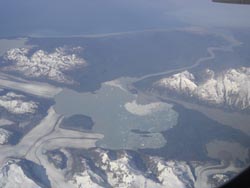Alaska Fish & Wildlife News
September 2011
Designated Wilderness
It’s Different in Alaska

Whether in books, reality television or seafood marketing, the words “wild” and “Alaska” just seem to go together. Certainly much of Alaska is “wild” and we are fortunate to live in a land that stands in contrast to the developed areas in the contiguous 48 states. While many consider the “wild” areas of Alaska as “wilderness,” it is important to understand some of the legal distinctions between “designated wilderness” and other federal public lands. State biologists need to perform field work across all federal lands, and a wilderness designation can complicate that. The ANILCA Program at ADF&G helps biologists navigate the federal process.
Fueled by the nation’s rapid growth in the 1940’s and 1950’s, and fears that development would eventually encompass all natural areas, Congress passed the Wilderness Act of 1964, which established the National Wilderness Preservation System. For an area to become designated wilderness it must be federal land and meet minimum size requirements; exhibit characteristics such as naturalness; and provide opportunities for solitude or primitive, unconfined recreation. Wilderness can only be designated by Congress, and federal land management agencies follow a specific process to identify areas for recommendation, which begins with conducting a “wilderness review” to determine if an area is eligible and suitable for designation as wilderness. Agency recommendations are forwarded by the Secretary of Interior or Agriculture to the President, who then makes a recommendation to Congress for final consideration.
Once established, designated wilderness areas, by law, are
…administered for the use and enjoyment of the American people in such manner as will leave them unimpaired for future use and enjoyment as wilderness, and so as to provide for the protection of these areas, the preservation of their wilderness character, and for the gathering and dissemination of information regarding their use and enjoyment as wilderness...
and are “devoted to the public purposes of recreational, scenic, scientific, educational, conservation, and historical use.”
In order to maintain wilderness character, as required by the Wilderness Act, these areas are the most restrictively managed federal lands. With exceptions, the Wilderness Act generally prohibits permanent and temporary roads, and unless necessary for management of the area, commercial enterprise, motor vehicles, motorized equipment, motorboats, aircraft landings, mechanical transport, structures, or installations. The federal agencies use a “minimum requirements analysis” to determine if an otherwise prohibited use, such as a helicopter landing, is necessary within designated wilderness.
During the many hearings leading up to the passage of the Alaska National Interest Lands Conservation Act (ANILCA) of 1980, Congress recognized that Alaskan conservation system units, including designated wilderness areas, must be managed differently to address Alaska’s fledgling economy and infrastructure, and distinctive way of life. Prohibiting modes of access such as snowmachines, dogsleds, motorboats, or airplanes would have effectively closed these areas to all use. It was also recognized that because of the unprecedented acreage of land under consideration as wilderness and because many people lived in and adjacent to these areas, allowances were necessary to accommodate the unique Alaskan lifestyle.

Therefore, ANILCA allows the use of snowmachines, motorboats, airplanes, and non-motorized surface transportation, such as dog sleds and pack animals, for traditional activities, which include hunting, fishing, trapping, and recreation in Alaskan designated wilderness areas. Subsistence users are allowed to use snowmachines, motorboats, and other forms of transportation traditionally employed for subsistence purposes. Additionally, ANILCA provides for use and construction of cabins within designated wilderness for subsistence uses by local area residents and for public health and safety reasons.
In regards to the management of fish and wildlife, the Department of Fish and Game is responsible for the sustainability of all fish and wildlife in Alaska, regardless of land ownership or designation, and has the authority, jurisdiction, and responsibility to manage, control, and regulate fish and wildlife populations – including for subsistence purposes – unless specifically preempted by federal law. ANILCA, as well as the Wilderness Act, recognized the State’s management authority regarding fish and wildlife on federal lands. Throughout the legislative history of ANILCA, Congress recognized Alaska as having a world-respected fish and wildlife management agency and, in Section 1314 of ANILCA, stated that nothing was intended to change the State of Alaska’s authority and responsibility for the management of fish and wildlife, except as provided in the subsistence title (Title VIII).
While the Wilderness Act prohibits certain activities, the Department still has the responsibility to conduct fish and wildlife management actions within designated wilderness areas. However, it must comply with applicable federal law and biologists and others planning fieldwork in designated wilderness must coordinate closely with the federal land manager. By working together with federal land managers to comply with provisions of the Wilderness Act, administrative activities within designated wilderness are possible.
If you have questions or would like to discuss this topic further, please call Brad Palach 267-2145 or Andrew Levi 267-2242.
Subscribe to be notified about new issues
Receive a monthly notice about new issues and articles.
